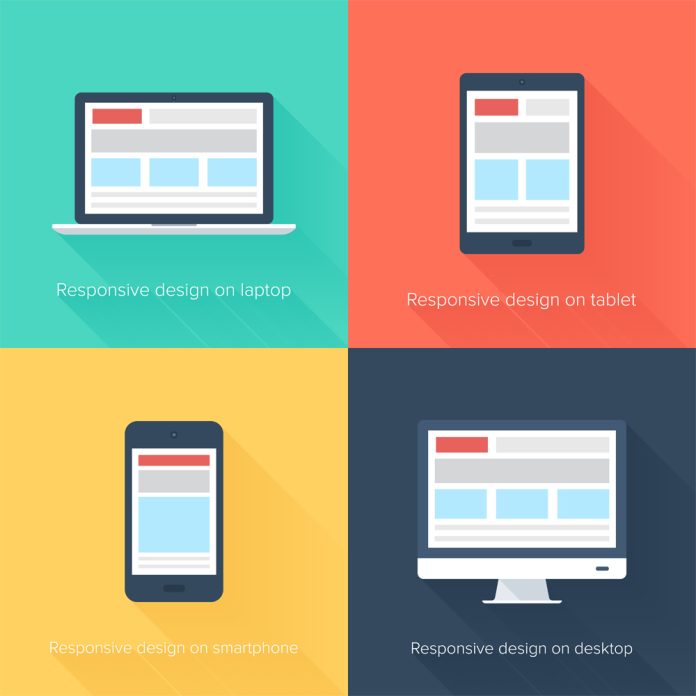When designing websites to work well on multiple devices, there are two main options – responsive and adaptive design. Both approach the problem of supporting diverse screens and browsers differently. This guide examines the pros, cons, and best uses for each technique to help choose the right one.
What is Responsive Web Design? Responsive web design (RWD) relies on flexible layouts, images, grids, and CSS media queries to automatically scale a single set of web pages perfectly across phones, tablets, laptops, and desktops. The goal is to provide an optimal viewing and interaction experience tailored to the visitor’s screen size without limiting functionality.
Responsive Design Capabilities
Here are some key capabilities of properly implemented responsive designs:
- Fluid Flexible Layout – Uses % CSS values instead of fixed pixels to stretch and contract.
- Reflowing Content – Dynamically shuffles page elements to fit smaller viewports.
- Responsive Images – Images are automatically served at appropriate resolutions.
- Media Queries – Element CSS properties adapt based on viewport characteristics.
- Mobile First Ideology – UX/UI designed first for mobile usage.
- Graceful Degradation – Website core functions even on very basic browsers.
- One Set of Code – A single codebase runs smoothly across all devices.
- Search Engine Friendly – No duplicate content issues.
What is Adaptive Web Design?
Adaptive web design relies on serving different page versions tuned specifically for broad device categories like desktop, tablet, and mobile. For example, there may be entirely distinct layouts, branding styles, templates, assets, and content for phone versus laptop visitors.
Adaptive Techniques Some ways adaptive design tailors experiences for groups of devices:
- Separate Templates – Unique page templates created for different-sized screens.
- Device Detection – The server identifies the category of the device through headers to serve adaptive assets.
- Alternate Navigation – Structural changes to menus, calls-to-action, and page links to better suit form factors.
- Adaptive Media – Dedicated image sizes, videos, and other media optimized per device type.
- Selective Content – Curated content served as suitable to mobile versus desktop usage.
- Component Swapping – Different page modules are shown to phone versus desktop users.
Comparing Adaptive and Responsive Design
While both approaches aim to provide an optimal experience regardless of device, there are some key conceptual differences:
- Responsive Adaptive
- Fluid & Flexible Fixed Layouts
- Dynamic Scaling Preset Breakpoints
- Content Reflows Separate Templates
- Progressive Enhancement Graceful Degradation
- Mobile First Desktop First
- Single Codebase Multiple Codebases
- SEO-Friendly Duplicate Content Risk
Which is Better Overall?
While equal in capabilities today, responsive design has some inherent advantages that make it superior for most websites:
- Simpler Development – Just one codebase lowers overall build effort.
- Easier Maintenance – Updating one set of templates and assets is more efficient long term.
- Lower Overhead – No need to store separate sets of large images and videos.
- Search Engine Friendly – Avoid duplicate content penalties from multiple URLs serving similar content.
- Future Friendly – New viewports and devices can be handled automatically through flexible fluidity.
The Case for Adaptive Design
While responsive design may be preferable in many cases, there are certain situations where adaptive techniques still excel:
- Highly Complex Sites – Simplifying very intricate pages for mobile users into adaptive experiences may be easier.
- Customer Comfort – Users familiar with past non-responsive sites may find adaptive design less disruptive during a transition period.
- App Migration – Adaptive sites can serve as an interim stepping stone when gradually shifting functionality from native apps to mobile web experiences.
- Legacy Platform Limitations – Upgrading outdated systems like old CMSs or e-commerce platforms to full responsiveness may be cost-prohibitive or technically challenging.
Best Practices for Implementation
If embracing responsive design, follow these guidelines for success:
- Mobile First Design – Structure UX/UI from the smallest screens upward for ideal flexible scaling.
- Fluid Grid – Utilize flexible percentage-based CSS grid layouts able to contract and stretch.
- Flexible Images – Set images to 100% parent container widths for automatic resizing.
- Media Queries – Extensively customize layouts, typography, colors, and styles based on viewport size breakpoints.
- Graceful Degradation – Simplify features for capable browsers while hiding advanced functionality.
- Testing – Thoroughly test responsive behavior across real devices and emulators.
When implementing adaptive design instead, heed this advice:
- Consistent Branding – Maintain a consistent brand identity across templates for cohesive user familiarity.
- Clear Navigation – Link device-specific page variations together with tabs or dropdowns to prevent dead ends.
- Promote Mobile Site – Make mobile users aware of the dedicated site alternative available to them on smaller screens.
- Analytics Review – Leverage reports to measure mobile site usage rates and gather conversion data prompting further adaptive refinement.
In both cases, extensive testing on actual devices is essential to smooth out quirks and deliver a polished experience.
Adding Responsiveness to Adaptive Sites
The technical constraints forcing some organizations to initially embrace adaptive techniques often ease over time. Major content management systems and e-commerce platforms now include integrated responsive functionality. When the opportunity arises to upgrade, consider ways to incrementally add responsiveness to supplementary site content like:
- Blogs / News – Supplementary informational content less reliant on complex backend processes tends to be easier to transition to fully responsive frameworks.
- Support Pages – Similarly, FAQs, contact forms, and other supporting content can often be consolidated around responsive designs readily.
- Marketing Pages – Lead generation landing pages, campaign microsites, and other front-facing materials also typically work well responsively.
- User Profile Pages – Front-end account management pages can usually be upgraded to responsive without impacting complicated backend account tools and databases.
Start by picking off easier pieces in a hybrid approach before addressing complex workflows and templates.
Responsive Design Tips & Tricks
These tips will help in going beyond just making sites functional responsively to creating excellent responsive user experiences:
- Dynamic Fonts – Allow font sizes to scale smoothly across screen sizes instead of fixed values.
- Flexible Ratios – For elements like image galleries and columns, express dimensions through ratios instead of hard values to reinvent alignments responsively.
- Breakpoint Overlap – Intentionally overlaps media query breakpoints by ~50 pixels to avoid abrupt layout shifts between viewports.
- Scroll Effects – Pull users down pages and highlight sections artfully by animating anchor links with JavaScript.
- Off-Canvas Navigation – Hide navigation initially for larger screens before elegantly sliding into view when clicked enhancing vertical space usage.
- Context Reformatting – Some text content like tables reflows poorly responsively. Detect screen size server-side and output alternate mobile-friendly HTML markup when needed.
- State Saving – Preserve form field values, rich text editor drafts, and other user-entered data if screen size changes force a page refresh.
Tools for Responsive Design
Building fully responsive designs from scratch requires significant web development expertise. Leveraging tools like page builders and frameworks is highly recommended:
- Page Builders – Visually construct responsive page layouts with drag-and-drop simplicity. Examples include Elementor, Beaver Builder, and Oxygen.
- Frameworks – Powerful CSS/JavaScript foundations like Bootstrap, Bulma, and Foundation kickstart development with responsive functionality built-in.
These tools make creating excellent responsive experiences much more accessible to web designers and non-technical users.
The Importance of Testing
Whether embracing responsive or adaptive models, extensive testing is mandatory before launching to the public. Be sure to check:
- Popular Devices – Directly open and interact with sites across phone, tablet, and desktop screens to catch basic issues.
- Browsers – Verify cross-browser compatibility for all major web browsers within each device category.
- Connectivity – Slow 3G connections can unveil performance problems flowing responsive image assets.
- Orientations – Switch devices between landscape and portrait modes observing layout, scrolling, and touching target issues.
- Interactions – Human testing clicks, taps, form inputs, and all site features catching problems automation alone may miss.
- Automated – Leverage tools like Browserstack and Lambdatest for added cross-browser, and cross-device test coverage.
- Accessibility – Use online test tools to catch accessibility problems impacting disabled users.
Testing early and often smooths over quirks in either adaptive or responsive approaches.
Conclusion
Responsive web design typically delivers the best results through streamlined flexible code powering pixel-perfect experiences across all modern devices. But in special cases where utterly revamping dated platforms poses too great a challenge, elements of adaptive techniques can serve as an interim step in the mobile transition before ultimately progressing to fully responsive models.
With rigorous design, development, and testing practices factored in from the start, both approaches can deliver excellent results. The best path forward depends largely on each organization’s unique technical constraints and project challenges at hand.








